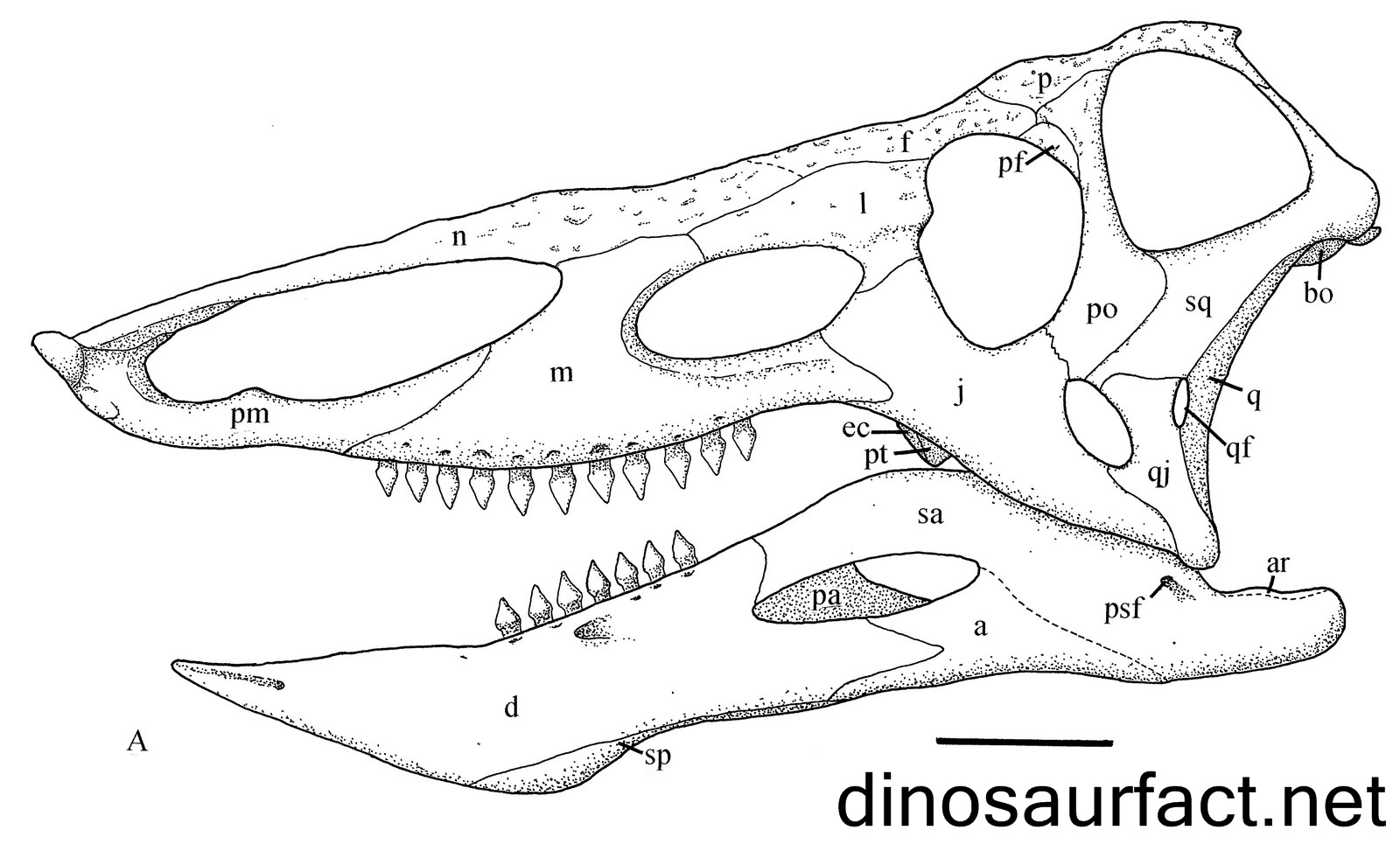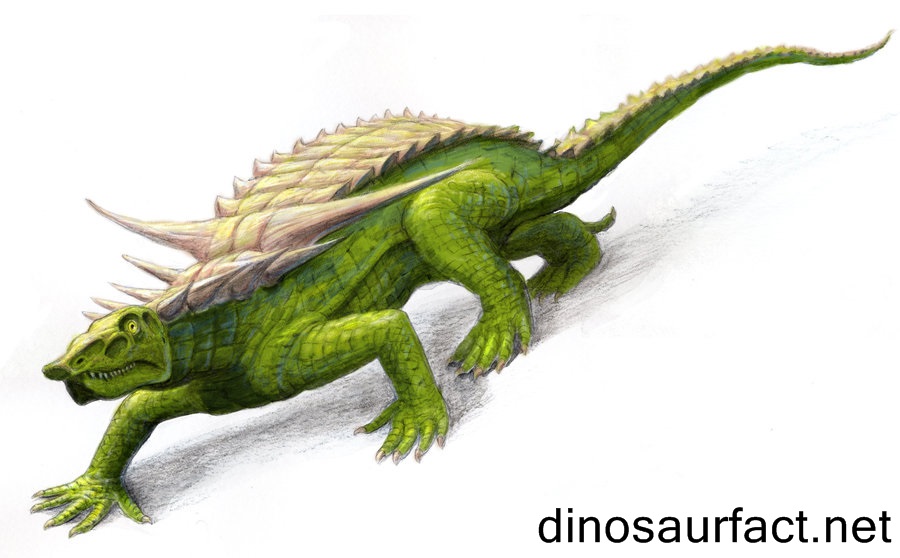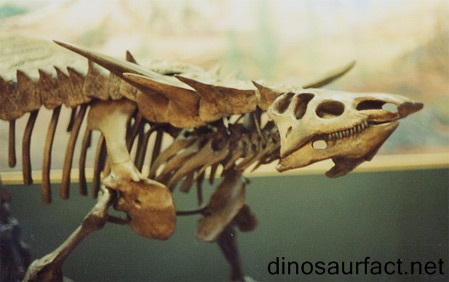 Click to visit the previous dinosaur bio
Click to visit the previous dinosaur bio
 |
|
 |
|
Kingdom: Animalia
Phylum: Chordata
Order: Therapsida
Family: Stagonolepididae
Genus: Desmatosuchus
 |
|
 |
|
 |
|

The Desmatosuchus (“link crocodile”) is a creature belonging to the Archosaur genus that includes present day birds and crocodiles. It lived during the late Triassic period in what is now Texas, USA in the continent of Northern America. It is believed to have lived in the middle to upper Triassic period, around 230 million years ago and is now extinct.
Discovery and identification
The first Dematosuchus bones were identified in the Southern Parts of the North American Continent. Cope was the first to describe the Desmatosuchus in 1892 and the material was named Episcopaurus haplocerus. In 1920, Case first put forward the Desmatosuchus spurensis. Both these species were considered to be phytosaurs. In 1953, Gregory modified the studies by Case and Cope and thus established D. spurensis and D. haplocerus as the only species of the Desmatosuchus dinosaur.
The geography of the locations of the fossil findings of the Desmatosuchus suggest it lived in the marshy floodplains of rivers in what are now the regions of Texas, New Mexico and Arizona. The fossils were found in the Chinle and Dockum formations of the North American continent.
There is a Dematosuchus fossil on exhibit at the Museum of Natural History, University of Michigan.
The Carnian and Norian stages of the upper Triassic
Although most data suggests that the Desmatosuchus lived in the Late Triassic Period, some data suggests that it also existed during the Middle Triassic period. However, evidence of such is very little. The Desmatosuchus is believed to have lived throughout the Upper Triassic period, from the Carnian Stage right up to the Norian stage.
The Carnian stage is the lowermost stage of the Upper Triassic (or the earliest stage of the Late Triassic). It lasted from approximately 235 to 228 billion years ago. The Norian stage is the successor to the Carnian stage and last from 228 to 208.5 billion years ago.
The Chinle and Dockum Formations
The Chinle Formation is a part of the Colorado plateau and the Interior Plains. It is an upper Triassic continental geological formation in the southwestern region of North America. The Dockum is a late Triassic group found majorly in the eastern parts of New Mexico and western Texas. The Chinle and Dockum formations are believed to have been deposited at roughly the same amount of time. This is because they comprise of many of the same vertebrates and plant fossils. The reconstructed ecosystems from fossils from both the formations are similar. The Rio Grande separates the two formations. Since they are deposited in different basins, the Chinle and Dockum formations are believed to be separate units.
Physical Features and anatomy
- The Desmatosuchus is one of the largest known aetosaurs.
- It reached up to 5 meters (or sixteen feet) long and was roughly 1.5 meters tall.
- The weight of this creature is approximated to be from 500-1000 pounds.
- The biggest anatomical feature about the Desmatosuchus is the armor along its back like many other aetosaurs.
- But what differentiated it from the other Aetosaurs of the time was that it also hosted two rows of spikes along its back.
- The largest two of the spikes were 45 centimeters long each.
- These provided the Desmatosuchus with extra protection against other predators.
- Another distinct feature of the Desmatosuchus is that it has large recurved spines on back of its neck.
- The Desmatosuchus had an upturned pig-nosed upper jaw membrane.
- The teeth of Dematosuchus seem to share characteristics with both the herbivorous aetosaurs and the carnivorous ones.
- The snout of the creature was shaped like a shovel, which helped in uprooting plants.
- The Tibia was missing from the creature’s anatomy.
- Also, there is evidence suggesting that it lacked a thumb and some backbones.
Recent studies and popularity
In 2005, Bill Parker discovered a new species D. smalli and also displayed that D. chamaensis is related to Paratypothorax more than it resembles Desmatosuchus. A distinct diagram showing the relations amongst the aetosaurs published in 2012 after an analysis by Julia Desojo, Martin Ezcurra and Edio E. Kischlat.
The Desmatosuchus appeared in “When Dinosaurs roamed America” and an episode of “Animal Armageddon”. There is also debate over whether or not, the Desmatosuchus is in fact, a Dinosaur.
About the Desmatosuchus
The shovel like snout and weak teeth suggest that the Desmatosuchus was predominantly an herbivore. It fed off fern-like vegetation and lived in marshy lands and forests of North America. The creature resembled the present day crocodile in various ways, particularly the stance, stout limbs and the scaly armored back. The manner of walking too was similar to that of a crocodile, with bent stout limbs and a large body.
It was a slow moving creature, owing to large body weight. This further strengthens the belief that it was an herbivore, since it didn’t require to move fast to prey on other creatures or escape other carnivores since it had a natural armor.
Despite being so large and having an impenetrable armor, the Desmatosuchus had a funny shaped skull, particularly owing to the pig shaped nose. Also, the head was without any kind of armor or protection thus making it a vulnerable target.
Besides the crocodile, the Desmatosuchus has several similarities with the modern day Armadillo. The resemblances include a scaly back and the pig-shaped nose. Also the curved snout is another corresponding similarity. Nests of various insects like bees and termites have been found from the Triassic timeline. So there is a probability that the Desmatosuchus could be omnivorous or at least insectivorous like the armadillo, as suggested by Murry and Long in 1996.
The Desmatosuchus is a step further in evolution from its basal Proterosuchus and Stagonolepis counterparts. The Desmatosuchus is ideal for studying other large aetosaurs from its time. Also there is a dearth of fossils from the Carnian period so the Desmatosuchus may play a key role in studying the habits of the dinosaurs from that period.
Just for fun we have a soundclip available for you to hear what a Desmatosuchus could've sounded like. Click to the Dinosaur Sounds area to hear it. Please note that the dinosaur sounds are only for entertainment and are not an actual fact.
Index
Extinct Profiles
 Triassic Dinosaurs
Triassic Dinosaurs Jurassic Dinosaurs
Jurassic Dinosaurs Cretaceous Dinosaurs
Cretaceous Dinosaurs Pterosaurs
Pterosaurs Marine Reptiles
Marine Reptiles Dinosaur Extinction
Dinosaur Extinction